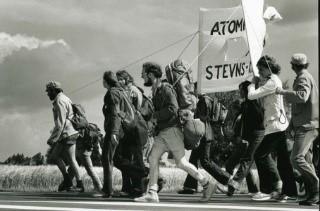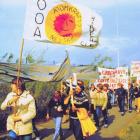
Campaign poster for the march from Gyllingnæs to Aarhus, Jutland, 1978
Campaign poster for the march from Gyllingnæs to Aarhus, Jutland, 1978
The original can be found here.
 This work is licensed under a Creative Commons Public Domain Mark 1.0 License.
This work is licensed under a Creative Commons Public Domain Mark 1.0 License.
On the weekend of 26 and 27 August 1978, Denmark witnessed the zenith of its activist anti-nuclear movement. Approximately 50,000 people—a higher turnout than any before or since—came together in two marches to protest plans for the erection of nuclear power plants. In the aftermath of the marches, opinion polls showed that 53% of the Danish population favored a non-nuclear future for Denmark, whereas 32% favored nuclear energy.
The experience of Danish anti-nuclear activism differed significantly from that of its counterparts in Western Europe. First, the Danish anti-nuclear movement—centrally organized in the Organization for Information about Nuclear Power (Organisationen til Oplysning om Atomkraft, OOA)—was able to successfully prevent the introduction of nuclear energy and the establishment of nuclear power plants in Denmark. Second, the movement was highly internationally orientated, particularly because the Swedish nuclear power plant Barsebäck, 20 kilometers from Copenhagen on the other side of the Sound, would present a serious threat to the Danish population in the case of an accident. Third, the Danish anti-nuclear movement’s attitude was characterized by political dialogue, non-partisanship, scientifically founded critique, and peaceful demonstrations.
In the mid-1970s, occupying building sites was a central strategy among anti-nuclear activists on both sides of the Atlantic—most prominently at the planned nuclear power plant at Wyhl in southern Germany. Danish activists, however, did not try to adopt this form of protest, but took lessons from the “mistakes” made at Wyhl. According to the OOA, protesters at Wyhl had not acted in a forward-looking way and had failed to propose alternative energy sources. Consequently, the OOA focused on actions combined with information campaigns and the scientific development of alternative, renewable energy solutions such as wind and solar energy, on the basis that this would “lead to a durable, deep understanding of the issues and support” for their views. This strategy is visibly incorporated into the internationally known Smiling Sun: Designed in April 1975 it combines an anti-nuclear message and presents the sun as an alternative energy source. Furthermore, its polite language (“Nuclear power? No thanks.”) fits OOA’s focus on dialogue.

Barsebäck march, 1980. The banner in the front shows The Smiling Sun or “solmærket”, which was designed by the Danish student Anne Lund. (Photo: Søren Rud)
Barsebäck march, 1980. The banner in the front shows The Smiling Sun or “solmærket”, which was designed by the Danish student Anne Lund. (Photo: Søren Rud)
This photograph was taken by Søren Rud when marching to Barsebäck on 13 September 1980.
This work is used by permission of the copyright holder.

March from Stevns to Copenhagen, 26 and 27 August 1978. Energimuseet, Denmark
March from Stevns to Copenhagen, 26 and 27 August 1978. Energimuseet, Denmark
This photograph belongs to Energimuseet, Denmark, and can be found here on Europeana.
 This work is licensed under a Creative Commons Attribution 4.0 International License.
This work is licensed under a Creative Commons Attribution 4.0 International License.
Danish activism benefitted from a high level of social trust in the state and the respectful mode of interaction between politicians and activists. However, the OOA activists criticized the political handling of violent confrontations and occupations in other countries—for instance, at the building site in Brokdorf in northern Germany, where individual OOA activists had participated. In the Danish activists’ discourse, these events served as examples of moral degradation and the evolution of a police state concomitant with the introduction of nuclear energy. Hence, their attitude was ambivalent: on the one hand, Danish anti-nuclear activists considered the violent demonstrations as a legitimate way for citizens to express their discontent with what they criticized as harassment by the authorities and attacks against democratic rights; on the other hand, Danish activists were not keen to organize similar protests that would harm their cause and provoke disaffection among the Danish citizens.
In fact, Danish anti-nuclear protest was very much inspired by the Danish peace movement of the 1950s and 1960s—and the OOA was closely connected to the Danish branch of the International Fellowship of Reconciliation (IFOR). In line with pacifist ideas, the OOA therefore also conceived nuclear energy as a threat against world peace. Hence, when 50,000 people joined the marches from the planned reactor sites in Gyllingnæs to Aarhus in Jutland in August 1978 and from the site at Stevns to Copenhagen on Zealand, the demonstrations resembled pacifist marches against nuclear weapons in previous decades. Designed as a unifying and peaceful undertaking, they started in smaller places and ended in bigger cities or the capital in order to encourage people to join in during the march and increase the number of participants, which again would influence the political importance of those marches. In this, the Danish anti-nuclear protests resembled some of the protests in the USA, which were rooted in the Society of Friends and were committed to non-violence.
Hence, the Danish anti-nuclear protests were based mainly on lessons drawn from experiences of demonstrations in other western countries. They turned the other protests’ failures to their advantage and focused on a convincing form of protest. Danish anti-nuclear activists excelled in the popularization of scientific evidence, political discussions and alternative energy plans for Denmark. Furthermore, Danish protests were inspired by pacifist marches and often organized their demonstrations in cooperation with Swedish activists. Consequently, Danish activists carefully selected and dismissed some forms of protests known by transnational connections, and thoughtfully integrated and adapted them to their social norms and political situation, which was more open to alternatives than in those countries, where nuclear power plants had already been established.
How to cite
Buns, Melina Antonia. “Marching Activists: Transnational Lessons for Danish Anti-Nuclear Protest.” Environment & Society Portal, Arcadia (Summer 2017), no. 18. Rachel Carson Center for Environment and Society. https://doi.org/10.5282/rcc/7918.
ISSN 2199-3408
Environment & Society Portal, Arcadia
 This work is licensed under a Creative Commons Attribution 4.0 International License.
This work is licensed under a Creative Commons Attribution 4.0 International License.
2017 Melina Antonia Buns
This refers only to the text and does not include any image rights.
Please click on an image to view its individual rights status.
- Hughes, Michael L. “Civil Disobedience in Transnational Perspective: American and West German Anti-Nuclear-Power Protesters, 1975–1982.” Historical Social Research 39, no. 1 (2014): 236–53.
- Jamison, Andrew, Ron Eyerman, Jacqueline Cramer, and Jeppe Læssøe. The Making of the New Environmental Consciousness: A Comparative Study of the Environmental Movements in Sweden, Denmark and the Netherlands. Edinburgh: Edinburgh University Press, 1990.
- Lund, Anne, and Finn Breinholt. “Dänemark—‘Atomkraft—Nein Danke.’ Wie man Atomkraft erfolgreich verhindern kann.” In Der Atomkonflikt. Atomindustrie, Atompolitik und Anti-Atom-Bewegung im internationalen Vergleich, edited by Lutz Mez, 83–100. Berlin: Verlag Olle & Wolter, 1979.
- Milder, Stephen. “Between Grassroots Activism and Transnational Aspirations: Anti-Nuclear Protest from the Rhine Valley to the Bundestag, 1974–1983.” Historical Social Research 39, no. 1 (2014): 191–211.
- Nehring, Holger. “Cold War, Apocalypse and Peaceful Atoms: Interpretation on Nuclear Energy in British and West German Anti-Nuclear Weapons Movements, 1955–1964.” Historical Social Research 29, no. 3 (2004): 150–70.
- Rasmussen, Søren Hein: Sære Alliancer. Politiske bevægelser i efterkrigstidens Danmark. Odense: Odense Universitetsforlag, 1997.
- Schanz, Elsebeth Aasted. “Den smilende sol. En aarhusiansk verdenshistorie.” Den Gamle Bys historiske hæfter 3 (2011).









